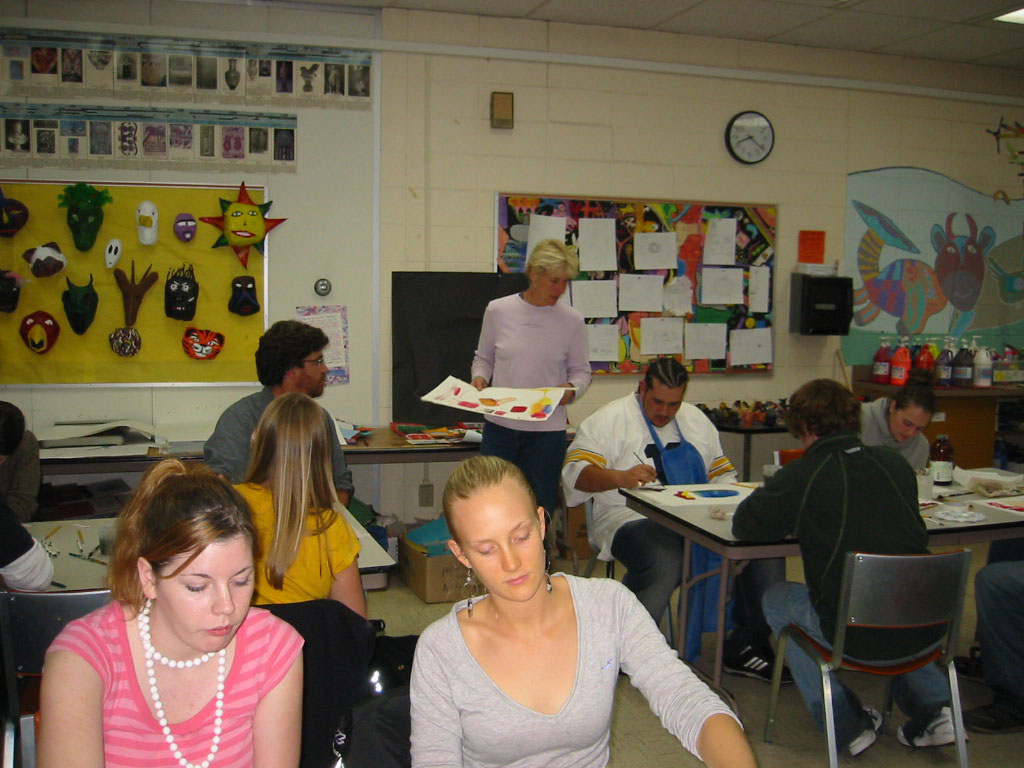|
|
|---|
Saturday, October 23, 2010
National Art Education Association - University of Idaho Student Chapter
University of Idaho students regularly present workshops at the Idaho Art Education Annual Conference, attend the national conference, and have sponsored a variety of workshops for the local community and the university.
The NAEA consists of over 22,000 art educators from every level of instruction: early childhood, elementary, secondary, college and university, administration, and museum education. Anyone and everyone concerned about quality art education in our schools can join the National Art Education Association; this includes publishers, manufacturers of art materials, parents, students, retired teachers, and those participating in arts councils and schools.
NAEA is a non-profit, educational organization dedicated to promoting art education through Professional Development, Service, Advancement of Knowledge, and Leadership. There are NAEA members from throughout the United States and twenty-five foreign countries.
To support and improve art education programs in our schools, NAEA pursues a policy of Education, Communication, and Empowerment. The NAEA produces and distributes national goals for quality art education and provides expertise, professional training, and tools which enable members to effect change on their local levels.
Freshman Information
How Parents Can Enhance Their UC San Diego Student’s Education
Parents and family members of UC San Diego students know the value of a good education. And they are aware that UCSD is one of the nation’s most accomplished research universities, widely acknowledged for its local impact, national influence and global reach.
 |
| UC San Diego students tutor at charter schools in our district, including The Preuss School on the UCSD campus. |
“At UC San Diego, we educate our students in the hope that they will grow into thoughtful, productive citizens so that we may one day place the care of our world into their capable hands,” notes Steven Adler, Warren College Provost, professor of Theatre and chair of the campus Council of Provosts. “But to do the job properly, we must rely on the generosity of UC San Diego parents.”
With higher education’s share of state revenue declining each year (only 12 percent of UC San Diego’s total budget is from the State of California), many families choose to support the Parents Fund as a way to enhance students’ educational experiences. Gifts of any size to the Parents Fund help maintain and strengthen UC San Diego’s Student Affairs programs, and also offer a pool of flexible dollars to each of the university’s six colleges— Revelle, John Muir, Thurgood Marshall, Warren, Eleanor Roosevelt and Sixth—to provide essential complements to classroom instruction.
 |
| Parent support to UC San Diego can positively impact students today, and in the future. |
Paul Volberding, M.D., and his wife Molly Cooke, M.D., appreciate the stellar education that our campus offers. Although both have been faculty members at UC San Francisco for over 30 years, two of their children are UC San Diego alumni. They are particularly pleased that UCSD helped their son, Benjamin, and daughter, Emily, take the next steps toward careers they love. “UCSD is a resource for scholars and scientists all over the world,” adds Dr. Volberding. “Supporting UC San Diego was an easy decision because the whole family feels it is their home. We are honored to be able to give back.”
Following is just a sampling of the many ways in which the UC San Diego Parents Fund helps students build leadership qualities, learn organizational skills and teamwork, as well as develop a lifelong affinity for stretching the mind and exploring the world.
- Model United Nations: Model UN members take on the role of diplomats and form delegations to attend conferences where student delegates debate international issues, give speeches, draft resolutions, form political alliances and resolve international conflicts from the perspective of their assigned country.
- Muir College Musical Ensemble: An annual production, this is the only musical on the UC San Diego campus that is performed and produced entirely by undergraduate students from all six colleges. The cast of actors and actresses is supported by a 15-piece orchestra and a production team of 20. This April, the ensemble will present the Cole Porter gem Kiss Me, Kate.
- Partner in Education: Colleges partner with charter schools in our district, including The Preuss School on the UCSD campus and Gompers, which provide a college prep education for motivated low-income middle and high school students. UC San Diego students are actively recruited to staff and tutor at these schools.
- Revelle in Rome: Scholarships offer a unique opportunity for students to study and explore Rome. This five-week summer session features two courses taught by UC San Diego History Department chair and professor John Marino, plus site visits in Rome and weekend trips to the countryside and Florence.
- And there’s more: Free newspapers including the San Diego Union-Tribune and New York Times for students, campus symposiums, free bike loans, artist-in-residency programs and so much more are made possible through the generosity of parent and family giving through the Parents Fund.By Judy Piercey
Friday, September 17, 2010
Herscel takes first image
Big planet, small star
Thursday, August 19, 2010
Cassini finds Titan clouds hang on to summer
MJ funeral may be bigger than Elvis
Saturday, August 14, 2010
The mystery of the missing sunspots explained
Ammonia on Saturn's moon
Wednesday, August 11, 2010
Moon mission picture of 1969 goes missing
Saturday, August 7, 2010
New black hole found
No water ice found in Japanese lunar mission
First orbital launch attempt by South Korea
Thursday, August 5, 2010
Fermi solves the mystery of gamma ray pulsars
Red giant star Betelgeuse is shrinking
Cosmic blobs and Galaxies
Saturday, July 10, 2010
Endeavour arrives at Space Station
Wednesday, June 16, 2010
Earth gravity and solar eclipse
Cosmic rays accelerated by exploded stars
Shuttle Endeavour finally launched
Friday, June 11, 2010
President Obama hails successful Hubble repair
Shuttle Endeavour launch on sunday postponed
NASA on Sunday postponed the launch of space shuttle Endeavour for the day due storms near Kennedy Space Center.
NASA will next try to launch the shuttle on Monday at 6:51 p.m.
Endeavour's launch was postponed twice last month because of a liquid hydrogen leak.
Endeavour, carrying seven astronauts and a key component for Japan's Kibo science laboratory, is to head to the International Space Station for a 16-day mission. Five spacewalks are planned for the crew after the shuttle docks.
Tuesday, June 8, 2010
Indian moon mission saved
Monday, May 31, 2010
NGC 6280 Nebula
Friday, May 28, 2010
Comet crystals feel the heat
The stellar outbursts occur when the growing young star accumulates a large amount of mass from the dusty, gaseous disc that is spinning around it. Each outburst sends a flash of heat permeating through the disc. At the distance the crystals were seen at, the temperature reached 725 degrees Celsius (about 1,000 kelvin), enough to thermally ‘anneal’ the silicate dust.
Young pulsar shows its hand
Tuesday, May 25, 2010
Something has struck Jupiter
Fireworks in Helix nebula
Sunday, May 23, 2010
Mars orbiter imagery boosts Curiosity rover's life search
Thursday, May 20, 2010
Venus nicknamed as Earth twin
Tuesday, May 18, 2010
Former astronaut Charles Bolden picked to lead NASA
Saturday, May 15, 2010
Exotic dust in comet trail
Friday, May 14, 2010
Solar wind tans young asteroids
Thursday, May 13, 2010
Friday landing for Endeavour
Wednesday, May 12, 2010
Gigantic bubbles boiling on the surface of star Betelgeuse
Saturday, May 8, 2010
A galaxy : Stephan Quintet
Friday, May 7, 2010
Never before seen photo shows Neil Armstrong face
Thursday, May 6, 2010
Is there a life in Universe ?
Fermi explores high energy “space invaders”
Wednesday, May 5, 2010
Astronauts test re-entry systems for Friday landing
Monday, May 3, 2010
200 Custom Postcards Printing Giveaway from UPrinting
To win the contest you need to leave a comment at the end of this post, describing what you would use the free custom greeting cards and/or custom postcards for. That’s all ! I will choose the 2 winners at random. Please be sure to include your name and email address so that I can contact you if your name is chosen.
(2) PRIZE WINNERS WILL RECEIVE 200 Custom Postcards (choose your size: 4x6, 4.25x6, 5x7"); 14pt gloss or matte, 13 pt uncoatedFull Color on both sides (4/4)Shipping must be paid by Winner. Offer Valid for UNITED STATES SHIPPING ONLY. The contest will end by 31st August and i will announce the winner shortly after.
Sunday, May 2, 2010
Space shuttle Endeavour launch postponed by leak
Friday, April 23, 2010
Details of our Milky Way
Tuesday, April 20, 2010
Moon bombing to probe water
Monday, April 12, 2010
Homeschooling and High School
Sunday, April 11, 2010
Student Education-NASA poised to stop work on shuttle extension option
As a result, NASA now plans to terminate work that kept open the option of a shuttle extension when the current legislation expires at the end of the month.
Saturday, April 10, 2010
Advice for Aspiring Homeschooler
Crunchy Con author and BeliefNet blogger, Rod Dreher, had a reader write to him seeking advice regarding homeschooling. A reader writes to say that his five year old came home from public school kindergarten with a flyer alerting parents that the kids are about to have a whole week of "Just Say No to Drugs" education. It shocked him that kids as young as this are being subjected to this sort of
Friday, April 9, 2010
Student Education-Evidence found of lake on Mars
Thursday, April 8, 2010
Student Education-Water molecules on Lunar surface
NASA scientists have discovered water molecules in the polar regions of the moon. Water molecules are greater than predicted , but still relatively small.
NASA's Moon Mineralogy Mapper, or M3, instrument reported the observations. M3 was carried into space on Oct. 22, 2008, aboard the Indian Space Research Organization's Chandrayaan-1 spacecraft. Data from the Visual and Infrared Mapping Spectrometer, or VIMS, on NASA's Cassini spacecraft and the High-Resolution Infrared Imaging Spectrometer on
NASA's EPOXI spacecraft contributed to confirmation of the finding. The spacecraft imaging spectrometers made it possible to map lunar water more effectively than ever before.
Wednesday, April 7, 2010
Student Education-Amazing Enceladus Images

In my previous post Happy Halloween from Cassini Spacecraft Team i mentioned about Cassini spacecraft going to the Moon of Saturn, Enceladus on 2th November, 2009.
Cassini has captured some amazing images of the plumes shooting from Enceladus , they are simply the raw images.
The objective of Cassini is to analyse the particles in the plume with the instruments that can detect the mass , size, charge, speed and composition.
These are the first images of the plume and are amazing.
Tuesday, April 6, 2010
Student Education-Hardball on Homeschooling
Monday, April 5, 2010
Student Education-A Christmas gift from Hubble Telescope
Until Christmas every day you can see a new image by Hubble Space Telescope . The images are awesome.













































